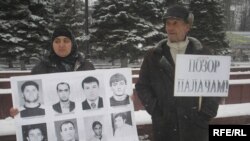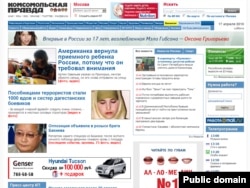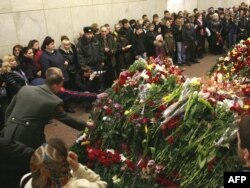At first, Aisha Makasharipova says she wasn't sure why she was being followed.
A resident of Makhachkala, the capital of Russia's North Caucasus republic of Daghestan, Makasharipova began noticing a few weeks ago that she had unwanted company on her way home from work.
"I'm a sales clerk, and when I leave for home at 11 p.m. it's dark. On the way home I began noticing cars with tinted windows and men on foot following and watching me," Makasharipova says.
"I asked a friend to accompany me home because I was afraid. I didn't know what this was connected to. My mother wants me to quit my job and stay home. I feel like my life is in danger."
Soon enough, Makasharipova found out what was going on. The Russian daily newspaper "Komsomolskaya pravda" on April 9 published the photographs of 22 women whose relatives were killed by Russian forces and whom law enforcement officials suspect could become potential suicide bombers.
Makasharipova, a 30-year-old mother of four, was on the list. The reason: her brother Rasul was killed in fighting with Russian forces in 2005.
"This is absurd. I am the mother of four children. My life is full. I go to work, come home, take care of my children, and go to work again," Makasharipova tells RFE/RL's North Caucasus Service.
"I'm in shock. My mother is in shock. All my friends were in shock after seeing this."
Fear Of The Black Widows
In the aftermath of the March 29 attack in the Moscow subway, when two female suicide bombers killed dozens of rush-hour commuters, law enforcement is paying especially close attention to the widows and sisters of militants killed by Russian forces in the volatile North Caucasus region.
Dubbed the "Black Widows," women who lost male relatives in the strife-torn North Caucasus have indeed participated in a series of terrorist attacks in Russia in recent years. They have blown up two airliners, detonated a bomb at a rock concert, and attacked the Moscow subway twice, most recently on March 29.
The decision by a major media outlet to publicize some of the women's names has outraged rights defenders even more.
Speaking to RFE/RL's Russian Service, "Komsomolskaya pravda" correspondent Aleksandr Kots, who wrote the article accompanying the photos of the women, says the material was provided by law enforcement officials who suspect "these women have connections to underground terrorist groups in Daghestan."
He defends the newspaper's decision to publish the material, arguing that it was in the public interest. "We aren't talking about suspicion here. We are talking about preventive measures," Kots says.
"As I understand things, these women are being monitored by the law enforcement bodies in Daghestan to make sure that none of them decides to come to Moscow to blow herself up in the subway."
Kots adds that publishing such information was necessary in a competitive journalistic market. "I am a correspondent and it is my job to get exclusive information. We all live in a market economy and we all need to surprise our readers," Kots says. "We didn't publish the whole list. Names we weren't certain about, that we couldn't confirm, we didn't publish."
Legal Ambiguity
Was publishing such material legal? Attorneys note that the law on such matters is filled with loopholes and ambiguity.
"The Civil Code forbids the publication of any person's image without their consent unless there is an overriding state or public interest at stake. What constitutes a state or public interest? The Civil Code does not speak to this. This is a slippery slope for journalists," Andrei Richter, director of the Moscow-based Institute for Information Law, tells RFE/RL's Russian Service.
Richter adds that journalists are also allowed to publish personal data about private citizens if the information was provided by law enforcement officials after a formal request. It is not clear whether "Komsomolskaya pravda" received the information about the women following an official query or via an informal leak.
But despite the ambiguities in the law, Richter strongly suggests that the publication of the women's photos and personal data was unethical.
"The ethical norms in our country -- the Russian code of journalistic ethics and the Reporters' Guild code of ethics -- say journalists must not violate the presumption of innocence," Richter says. "They must not violate the principle that a person is innocent until he is officially charged and convicted of committing a crime."
Among the women "Komsomolskaya pravda" named as potential suicide bombers were some unlikely figures -- like well-known Daghestani activist Gulnara Rustamova, co-chairwoman of the organization Mothers of Daghestan for Human Rights.
Rustamova says her organization is often accused of supporting and defending terrorists. But she adds that law enforcement officials are never able to say exactly how this is the case.
"These law-enforcement officials need to show their evidence," Rustamova says. "I had conversations with people from law enforcement and asked them what complaints they had about me. They couldn't come up with any. If there were any complaints, they long ago would have prepared a case, charged me with whatever it is they suspect I am doing, and gone to trial."
Rustamova says that like Makasharipova, many other women whose photographs were published have complained to her organization about being followed by suspicious men in cars with dark windows.
Aleksandr Cherkasov of the human rights group Memorial tells RFE/RL's Echo of the Caucasus that casting suspicion on the relatives of militants is reminiscent of Soviet-era practices.
"Many of these women live completely in the open and nobody has detained them. What does this mean? It means that measures like this are an imitation of strength. It means [the authorities] don't want to act in accordance with the law," Cherkasov says. "We've already been through this kind of thing -- holding relatives responsible -- in the Soviet period."
written by Brian Whitmore in Prague. With reporting by Elena Polyakovskaya of RFE/RL's Russian Service, Murtazali Dugrichilov of RFE/RL's North Caucasus Service, and Andrei Babitsky of RFE/RL's Echo of the Caucasus
A resident of Makhachkala, the capital of Russia's North Caucasus republic of Daghestan, Makasharipova began noticing a few weeks ago that she had unwanted company on her way home from work.
"I'm a sales clerk, and when I leave for home at 11 p.m. it's dark. On the way home I began noticing cars with tinted windows and men on foot following and watching me," Makasharipova says.
"I asked a friend to accompany me home because I was afraid. I didn't know what this was connected to. My mother wants me to quit my job and stay home. I feel like my life is in danger."
Soon enough, Makasharipova found out what was going on. The Russian daily newspaper "Komsomolskaya pravda" on April 9 published the photographs of 22 women whose relatives were killed by Russian forces and whom law enforcement officials suspect could become potential suicide bombers.
Makasharipova, a 30-year-old mother of four, was on the list. The reason: her brother Rasul was killed in fighting with Russian forces in 2005.
A screen grab of the "Komsomolskaya pravda" website of April 9, whose second headline asserts that "1,000 Wives And Sisters Of Daghestani Fighters Become Terrorist Accomplices." (Click to enlarge)
Makasharipova says that when her relatives showed her the newspaper with her picture and personal data, she was shocked. She denies any connection to terrorism and has vowed to sue the newspaper over the publication."This is absurd. I am the mother of four children. My life is full. I go to work, come home, take care of my children, and go to work again," Makasharipova tells RFE/RL's North Caucasus Service.
"I'm in shock. My mother is in shock. All my friends were in shock after seeing this."
Fear Of The Black Widows
In the aftermath of the March 29 attack in the Moscow subway, when two female suicide bombers killed dozens of rush-hour commuters, law enforcement is paying especially close attention to the widows and sisters of militants killed by Russian forces in the volatile North Caucasus region.
Dubbed the "Black Widows," women who lost male relatives in the strife-torn North Caucasus have indeed participated in a series of terrorist attacks in Russia in recent years. They have blown up two airliners, detonated a bomb at a rock concert, and attacked the Moscow subway twice, most recently on March 29.
Russians stand near flowers commemorating victims of the metro attack inside the Lubyanka Metro station in Moscow on March 30.
But critics allege that in their zeal to prevent the Black Widows from striking again, Russian law enforcement is casting too wide a net and essentially branding the female relatives of militants in Chechnya and Daghestan guilty until proven innocent.The decision by a major media outlet to publicize some of the women's names has outraged rights defenders even more.
Speaking to RFE/RL's Russian Service, "Komsomolskaya pravda" correspondent Aleksandr Kots, who wrote the article accompanying the photos of the women, says the material was provided by law enforcement officials who suspect "these women have connections to underground terrorist groups in Daghestan."
He defends the newspaper's decision to publish the material, arguing that it was in the public interest. "We aren't talking about suspicion here. We are talking about preventive measures," Kots says.
"As I understand things, these women are being monitored by the law enforcement bodies in Daghestan to make sure that none of them decides to come to Moscow to blow herself up in the subway."
Kots adds that publishing such information was necessary in a competitive journalistic market. "I am a correspondent and it is my job to get exclusive information. We all live in a market economy and we all need to surprise our readers," Kots says. "We didn't publish the whole list. Names we weren't certain about, that we couldn't confirm, we didn't publish."
Legal Ambiguity
Was publishing such material legal? Attorneys note that the law on such matters is filled with loopholes and ambiguity.
"The Civil Code forbids the publication of any person's image without their consent unless there is an overriding state or public interest at stake. What constitutes a state or public interest? The Civil Code does not speak to this. This is a slippery slope for journalists," Andrei Richter, director of the Moscow-based Institute for Information Law, tells RFE/RL's Russian Service.
Richter adds that journalists are also allowed to publish personal data about private citizens if the information was provided by law enforcement officials after a formal request. It is not clear whether "Komsomolskaya pravda" received the information about the women following an official query or via an informal leak.
But despite the ambiguities in the law, Richter strongly suggests that the publication of the women's photos and personal data was unethical.
"The ethical norms in our country -- the Russian code of journalistic ethics and the Reporters' Guild code of ethics -- say journalists must not violate the presumption of innocence," Richter says. "They must not violate the principle that a person is innocent until he is officially charged and convicted of committing a crime."
Among the women "Komsomolskaya pravda" named as potential suicide bombers were some unlikely figures -- like well-known Daghestani activist Gulnara Rustamova, co-chairwoman of the organization Mothers of Daghestan for Human Rights.
Rustamova says her organization is often accused of supporting and defending terrorists. But she adds that law enforcement officials are never able to say exactly how this is the case.
"These law-enforcement officials need to show their evidence," Rustamova says. "I had conversations with people from law enforcement and asked them what complaints they had about me. They couldn't come up with any. If there were any complaints, they long ago would have prepared a case, charged me with whatever it is they suspect I am doing, and gone to trial."
Rustamova says that like Makasharipova, many other women whose photographs were published have complained to her organization about being followed by suspicious men in cars with dark windows.
Aleksandr Cherkasov of the human rights group Memorial tells RFE/RL's Echo of the Caucasus that casting suspicion on the relatives of militants is reminiscent of Soviet-era practices.
"Many of these women live completely in the open and nobody has detained them. What does this mean? It means that measures like this are an imitation of strength. It means [the authorities] don't want to act in accordance with the law," Cherkasov says. "We've already been through this kind of thing -- holding relatives responsible -- in the Soviet period."
written by Brian Whitmore in Prague. With reporting by Elena Polyakovskaya of RFE/RL's Russian Service, Murtazali Dugrichilov of RFE/RL's North Caucasus Service, and Andrei Babitsky of RFE/RL's Echo of the Caucasus



















